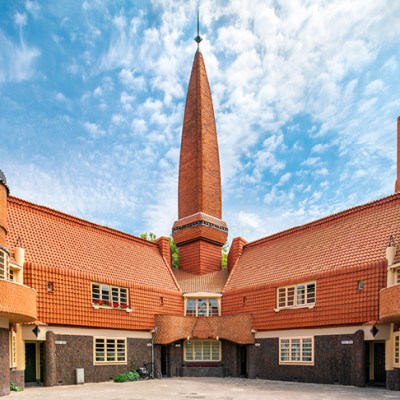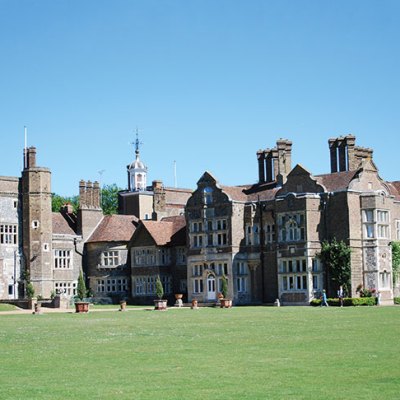There is a category of houses so famous that they can no longer be used as houses. Such buildings exist outside the practical needs they were built to address and are preserved much as works of art are. Victor Horta’s house in Brussels is one.
The Maison & Atelier Horta were designed by Victor Horta in 1898 to be both a family home and an architecture studio. Today they are home to the Horta Museum, an institution dedicated to celebrating the work of Brussels’ pioneering art nouveau architect. The house and studio – located on the rue Américaine in central Brussels – are both perfectly preserved, frozen at an imagined moment when they were still occupied by Horta and his family.
The museum is hosting, until 30 June, an exhibition on the theme of collecting. Horta’s own collection of Asian art and rare marble forms part of the displays, along with a private collection of art nouveau furniture curated by Jonathan Mangelinckx and a reflection on the act of collecting explored through video and embroidery by Elisabeth Horth. The exhibition runs through the house and the atelier as well as a third, purpose-built gallery space that has recently opened. It also coincides with a number of significant anniversaries: it is 100 years since Horta sold the house, 50 years since it opened as a museum and 30 years since an extensive restoration.
The exterior of the Maison & Atelier Horta. Photo: Paul Lewis; © Musée Horta

The exhibition is interesting in itself, helping to situate Horta’s work within the wider context of Belgian art nouveau, and Horth’s embroidery is extraordinarily delicate and skilful. In truth though, the museum’s main exhibit is the architect’s house. Horta’s career was long and distinguished but the period in which he designed his most important works was – like the style of art nouveau – intense and brief. During the 1880s his work was broadly Beaux Arts in inspiration, typified by the Edicule Lambeaux, an exquisite little classical pavilion he designed in 1890 for the Parc du Cinquantenaire in Brussels. The Maison Autrique, built in 1893, was innovative in the way it introduced riveted ironwork into a domestic interior, but it was the Hôtel Tassel (designed 1892–93) that marked a decisive stylistic and spatial departure. This work was Horta’s first fully realised art nouveau design, a remarkable and revolutionary new architectural style.
It was the start of a remarkably productive and inventive period for both Horta and Brussels, in which the city became the home of the architectural avant-garde of the time. Horta’s design for his own house and atelier was a mature work, but also one that marked the end of art nouveau for him. The house is a full-bodied expression of the style’s most significant tropes. It is all here: the ‘biomorphic whiplash’ lines, the floridly decorative use of iron and glass, the obsessively detailed joinery and the intense interplay of materials and surfaces. The interior is dreamlike and immersive; a spiralling journey that starts with the marble stairs in the reception rooms and continues up into the glazed and mirrored roof-space. Here at the very top, there is a giddy sense of aesthetic overload, of so much detail and design that it is hard to concentrate on any one aspect.
There are also, despite this, moments of tranquillity and a more humble domesticity – the little dark room and study on the second floor or the functional and beautiful basement kitchen, for example. But there are others where the materials and details of art nouveau seem at odds with the domestic programme. The dining room is lined with glazed brick and vaulting metalwork. It is impressive but also bizarre and off-key. Its materials and character are those of the public or commercial building, of the shopping arcade or the department store; it feels like a railway station waiting room inserted into a private house.
The dining room in what is now the Horta Museum, designed by Victor Horta to be his family home and architecture studio in 1898. Photo: Paul Lewis; © Musée Horta

Still, the house is ingeniously planned, full of intimate spaces but also generous and practical in places. Aside from the more obvious stylistic inventiveness of art nouveau, one of Horta’s most significant innovations was spatial, replacing the rigid organisation of a typical Belgian town house with free-flowing horizontal and vertical space.
There is also an undeniable sense of bourgeois luxury. The main bedroom is superb: large, lit by glazed doors and leading to a comfortable carpet-lined dressing room and a small but luxurious bathroom. Bizarrely, this has a secondary access directly from the service stair landing, presumably so that servants could fill its cast-iron tub with hot water without passing through the private bedroom spaces.
Horta’s work, like art nouveau itself, is an acquired taste. It has an immediacy that grabs people, and a lasting photogenic appeal that makes its masterpieces into tourist destinations. Here, architecture is also unmistakably ‘art’, packed full of exuberance and seemingly unrestrained invention. Those aspects of architecture most often prized by architects – spatial dexterity, material honesty and structural integrity – are submerged beneath crowd-pleasing acrobatics and exorbitant materials. Art nouveau is almost all fanfare, a five-course meal made up exclusively of hors d’oeuvres. One’s appetite for this depends on how much the more restrained and puritanical palate of modernism affects your judgement.
Interestingly, Horta himself never fully embraced modernity. The arc of his career lends weight to the idea that art nouveau was less a precursor to modernism than a brief interruption before it fully got going. Horta’s art nouveau period lasted all of 10 years. After this, his work returned to the more conservative form of Beaux-Arts classicism with which he started. Stylistically, art nouveau proved a dead end, somewhere from which it was impossible to move anywhere but backwards.
Perhaps this regression was necessary. Horta’s sympathies lay with emerging socialist political positions, but it is difficult to see how art nouveau could have offered much in the way of solutions to mass housing or other modernist programmes. Despite its innovations in construction, its success depended largely on expensive materials and intense levels of craftsmanship and therefore on essentially 19th-century models of production.
Horta’s achievements were also largely confined to houses for Brussels’ wealthy bourgeoisie. The Maison du Peuple was one of the very few public buildings he completed during his art nouveau period and was, inexplicably, demolished in the mid 1960s. Commissioned by the Société Coopérative Ouvrière de Bruxelles, it provided public space for gatherings and political discussion as well as musical and theatrical performances. The Maison du Peuple’s programme was essentially political and civic, offering an alternative to both the private domestic realm and the quasi-public world of restaurants and bars. It was a new kind of building with a genuinely radical agenda, something of a prototype for the ‘social condenser’ of the Russian constructivist period.
After 1900, Horta’s work grew in scale but reduced in ambition. His urban planning and smaller-scale schemes for rural housing became more traditional and familiar in both language and intent. The dream-like interiors of his art nouveau houses were gone. The Horta Museum preserves the architect’s house and – in a sense – his reputation. The building is unsullied by the disappointments of what came after. It remains a symbol of fin-de-siècle European culture: an exotic object and almost the last of its kind.
From the June 2019 issue of Apollo. Preview and subscribe here.



